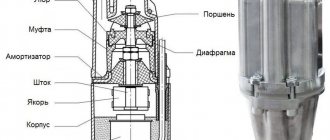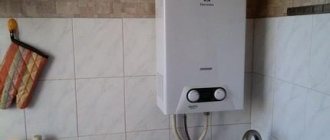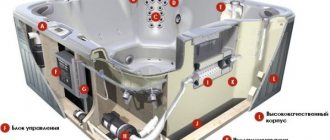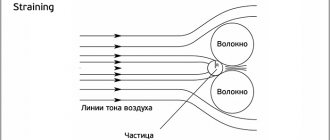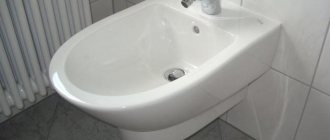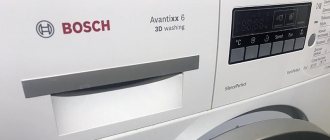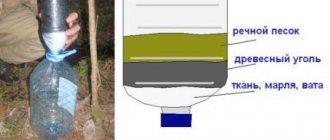An electric heated towel rail is a convenient and practical household appliance. It provides a comfortable microclimate in the bathroom, prevents the appearance of fungus and allows you to quickly dry towels. It lasts for a very long time. But sometimes force majeure circumstances occur, which you can fight with your own hands.
We will tell you how to identify a breakdown and then repair an electric heated towel rail that has stopped performing its functions. Here you will learn not only about the rules for restoring working capacity, but also about a simple option for improving the operation of the device.
Taking into account our recommendations, you can independently repair a heated towel rail connected to the power supply to fully restore its functions.
Why doesn't my electric heated towel rail work?
The cause of a breakdown or incorrect functioning of a heated towel rail is often the chain of nodes connecting the device to the power grid.
The search for a problem begins with examining the outlet. The plug is removed and the inlet openings are carefully inspected.
Due to the breakdown of the heated towel rail in the bathroom or combined bathroom, an excessively high level of humidity forms and there is a risk of mold.
If there is no visual damage, the node is examined using an indicator screwdriver. If there is no current, the socket is replaced with a working one, but when there is current, they proceed to checking the thermostat. They carefully rotate it and listen to the sound. A faint click is heard, indicating that the contacts are triggered and means that the device is working properly.
Next, the fault is looked for in the power line. When there is increased load on the network, it becomes hot and the device automatically turns off. In such a situation, the equipment is reconnected to the power supply and closely monitored.
Repeated knocking out of the breaker plug clearly indicates that there is a short circuit in the connection system that needs to be detected and eliminated.
Overheating of the connection is one of the most common causes of malfunction of an electric heated towel rail, so if the equipment fails, this is where the inspection can begin
Diagnostics of the system for a short circuit is carried out using a multimeter. It is configured to fix the DC resistance level.
The cord connecting the heated towel rail to the network is removed from the socket, and then the resistance of the heating element and the wire is measured. The heating element indicators should tend to zero and be slightly less than 1 Ohm. The resistance of the wire should approach infinity, since the circuit connecting the neutral and phase conductors is open.
A multimeter is a useful and convenient device that allows you to quickly identify the location of a short circuit in the electrical system. Can be useful when diagnosing wiring, batteries, batteries
If the device display shows other numbers, the damaged liner must be replaced. This takes a minimum of time and effort, provided that it is mounted openly.
If a hidden laying method is used, to eliminate the problem, it is necessary to remove fragments of the external wall decoration for a while, carry out the necessary repair work, and only then return the decorative elements back.
A heated towel rail with a hidden power line in the interior looks more attractive, but repairing the wiring if it is damaged will be more difficult
Detecting faults in the electrical circuit
According to the rules for the safe operation of a heated towel rail, installation of an outlet directly in the bathroom is carried out only if it is connected to the system through safety devices. In a network that complies with all PUE standards, a circuit breaker, an RCD device and wiring leading to the outlet are installed.
The residual current device will protect the heated towel rail from overvoltage and short circuit. The choice of RCD category depends on the voltage, rated current and number of poles
To locate the fault area, first check the position of all circuit breakers:
- A disconnected main circuit breaker with the RCD turned on means a short circuit in the system.
- The switched on main circuit breaker when the RCD is switched off signals a decrease in the level of insulation resistance on the heating element of the device.
- If, when the heated towel rail is disconnected from the outlet, both disconnected machines turn on easily and do not turn off, problems should be looked for in the device itself. When one of them turns off the protective system immediately after switching on, the problem lies in the liner.
- If, when the heated towel rail is plugged in, the machines turn on, but one of them knocks out, the fault is in the towel dryer.
A unit that is not working with two machines turned on clearly indicates that the heating element may be partially burned out or has already completely burned out and needs to be replaced.
Internal malfunctions of the electrical appliance
Electric heated towel rails are divided into two types. Some are called solid-filled and use graphite as a heating substance. The second - liquid - operate on special mineral oil, water or antifreeze.
When a solid or liquid heated towel rail stops functioning, the first thing to do is identify the area of the problem. If the wiring and external power network have been checked and are in perfect order, then it is most likely that the problem lies in the equipment itself.
A detailed search begins with determining whether the heated towel rail heats less or does not heat at all. To do this, turn on the device in standard mode, and after 5-7 minutes check the heating level in the area of the main heating element.
When in this place the unit becomes simply warm, but not fiery, they try to increase the temperature by additionally adjusting the thermostat.
If the temperature adjustment procedure helps, the problem is only a malfunction of the control equipment and no further action is required
When the heated towel rail warms up as much as possible only in the area of the heating element, and then remains barely warm or even cold, there is a possibility that it is simply clogged and needs proper cleaning. They do it with their own hands at home.
The device is disconnected from the network, removed from the wall and turned over so that the heating liquid does not leak out. Using a wrench, unscrew the main valve and clean the inlet hole with wire.
Then the unit is assembled, checked for leaks, returned to its usual place and connected to the power supply. Normal operation of the device in standard mode means that the repair was successful.
If the heating element does not heat up at all, the source of the problem is sought in the electrical part of the unit.
Horizontal and vertical models in the interior: photos
Photo 5. Vertical wall-mounted heated towel rail “ladder” with 5 arcs and a chrome surface in combination with a bathroom in wenge color.
Photo 6. A designer model of a vertical heated towel rail with a matte surface not only warms the bathroom, but is also an effective wall decoration.
Photo 7. The simplest form of a vertical heated towel rail with a bottom supply to the riser, is very convenient in everyday life due to the large number of arcs.
Photo 8. An impressively sized horizontal heated towel rail model with a bottom connection to the riser will do an excellent job of heating large bathrooms.
Photo 9. A horizontal black heated towel rail in a high-tech style will successfully complement the minimalist interior of the room.
Troubleshooting Electrical System Problems
When it is already known for sure that the problem with a non-working heated towel rail lies not in the electrical network, but in the device itself, you need to urgently find the location of the malfunction. Devices operating on the basis of a heating cable, in most cases, cannot be repaired or require complete replacement of the main element.
Almost all heating elements units can be repaired without problems and after maintenance work normally in standard mode.
To diagnose the heating element, you need to get to the contacts connecting it to the electrical supply system. To do this, first remove the casing covering the contact part. This process is carried out differently in each model and is usually described in the user manual included with the heated towel rail.
To check the functionality of the heating element, you must use the tester (multimeter) again. By checking the heating element with a multimeter, you can find out for sure whether it requires replacement or not.
The wires connecting the heating element to the general system are soldered or fastened with special contacts. They are carefully disconnected. Then, using a multimeter, they ring separately, first the wire, and then the heating element itself.
The measurement scale is set to “Ω” and the maximum value is indicated. The measurement is made between three passing wires and the indicator is recorded. It should be as high as possible. Data tending to 0 indicates the presence of a short circuit in the system.
If there is some kind of control equipment between the socket and the heating element, it is turned off and tested separately before measurement. Ignoring this item results in receiving incorrect data.
If there is a timer on the heated towel rail, the circuit between its contacts is also checked. The absence of a circuit is a sure signal that the timer requires replacement.
The examination of the heating element begins with checking the circuit between the power contacts. Then the presence and level of resistance between the power contacts and the housing is determined. If there is no circuit between the power contacts, then either the heating element itself or the thermostat is broken.
A low value of the resistance indicator between the power contacts and the body of the heating element indicates its damage or breakdown. In such a situation, the element is removed and replaced with a new one.
Work to replace the heating element
The configuration of most models of electric heated towel rails involves replacing a failed heating element with a new one. The procedure is not too complicated and can be done at home with your own hands using a screwdriver, pliers and a set of wrenches.
Before starting repair work, you need to find out what type of heating element is used in the heated towel rail model. The most common are “wet” heating elements, in which the heating element is in contact with the coolant liquid.
Before repairing such units, they are removed from the wall, turned over, the inlet valve is unscrewed and the working fluid (water, oil, distillate solution) is drained. Then unscrew the threaded connections that fasten the element to the body, replace the faulty heating element with a working one, fill in the heat-carrying liquid, close the outlet holes and check the installation for leaks.
To replace the heating element, the heated towel rail must be disconnected from the central electrical network, in other words, unplug the plug from the socket to de-energize the device
In “dry” versions, where the heating element and coolant are separated from each other, the faulty heating element is simply unscrewed from the body and a new one is installed in its place.
At the end of the work, the entire heating element is tested with a multimeter, and only if positive results are obtained in all areas, the equipment is installed back on the wall and the equipment is connected to the power supply system.
Main types of dryers
Different types of coils differ in shape and material from which they are made. Products made of stainless steel have a long service life. Their surface is not coated with additional coating, but is simply polished to a shine, thereby creating an attractive appearance.
As for brass and chrome-plated products, the service life varies from 5 to 10 years, after which replacement will be required.
We advise you to choose heated towel rail models that do not have jumpers or connecting seams.
, the diameter of the pipes and the shape of the dryer structure are important . Among the most common forms:
Depressurization of the system and loss of working fluid
The cause of unit malfunction is a violation of the integrity of the coolant container and, as a consequence, leakage of the working fluid. The culprits of this problem are usually sealing rings that have worn out during intensive use or have simply expired.
The easiest way to detect damage is. A puddle of leaked liquid of an oily yellow or dark shade forms on the bathroom floor directly under the heated towel rail and clearly indicates a malfunction.
To eliminate the breakdown, the heated towel rail is disconnected from the electrical supply system, removed from the wall, the valve at the inlet is unscrewed, the working fluid is drained and carefully disassembled at the point of depressurization using an adjustable wrench or a special tool provided by the design of the model.
The damaged sealing ring is removed and a new one, included with the device, is installed in its place.
If all branded o-rings have already been used, the product is purchased at a specialized store. Inexpensive gasket elements made of solid and semi-solid rubber are suitable for heated towel rails.
They remain operational at temperatures from -40 to +80°C, and some more modern types do not lose their physical characteristics even at temperatures from -20 to +90°C.
For the manufacture of gaskets for household electrical devices, technical rubber TMKShch (GOST 7338-90) is used. The abbreviation means that the products are resistant to alkali and have heat and frost resistance. They are recommended to be installed only in systems where the pressure does not exceed 25 bar
The only drawback of rubber gaskets is their fragility. During use, they quickly lose their elastic structure, delaminate or crack. When installing them in a heated towel rail, you should keep in mind that they will have to be changed quite often.
Sealing and gasket products made from paronite are more practical and can easily withstand system pressures of up to 64 bar. Unlike rubber options, they can easily withstand high thermal loads (up to +200°C), are resistant to sudden temperature changes and are not afraid of strong pressure typical of heating systems.
However, paronite contains chrysolite asbestos, which is considered harmful to human health. It contains some types of carcinogens that can provoke malignant and benign formations. In the Eurozone countries, asbestos is prohibited, so professionals do not recommend using paronite gaskets for household appliances.
Silicone gaskets are non-toxic and perform well, but their price is quite high. In addition, in hermetically sealed systems at temperatures above +150°C, the material softens, becomes porous, loses hardness and loses its original strength.
Parts made from fluorine-containing polymer are more expensive, but have unsurpassed physical, anti-friction and electrical properties. Fluoroplastic demonstrates complete harmlessness to humans and instantly extinguishes upon spontaneous combustion.
Gaskets and seals made from this progressive material practically do not age, withstand record high loads, work efficiently in aggressive conditions, and withstand operating temperatures up to +150°C and pressure up to 160 bar.
Once you replace the rubber or silicone sealing rings on your heated towel rail with fluoroplastic ones, you can forget about leaks forever
After replacing the gasket, the drained working fluid is poured into the unit. If its volume is not enough, the required amount is added from a spare container. If desired, the heat-conducting composition is completely changed to a new one. To prevent the system from breaking, be sure to leave an air “cushion” of 3 to 5 centimeters.
At the end of the service, the unit is reassembled, the incoming valve is tightened, checked for leaks, hung in its usual place and connected to the electrical network. A heated towel rail operating normally means the repair was successful.
Last news
Cold heated towel rail
Statement
I, full name, live at the address: ___________ st. ______________ d.___ apt. No. ___. Briefly describe the essence of the problem in your own words.
The heated towel rail is connected to a hot water supply pipe; therefore, this device is subject to the Rules for the provision of utility services to owners and users of premises in apartment buildings and residential buildings, approved by Decree of the Government of the Russian Federation No. 354 of May 6, 2011 and sanitary standards of Russian legislation (SanPin 2.1. 4.2496-09), the hot water temperature must be no lower than 60°C and no higher than 75°C.
In accordance with paragraph 31 of the Rules for the provision of utility services to owners and users of premises in apartment buildings and residential buildings adopted by Decree of the Government of the Russian Federation of May 6, 2011 N 354, an organization providing utility services to the consumer is obliged, independently or with the involvement of other persons, to carry out maintenance of intra-house engineering systems with the use of which utility services are provided to the consumer, as well as recalculate the amount of payment for utility services, including in connection with the provision of utility services of inadequate quality and (or) with interruptions exceeding the permissible duration.
In accordance with Article 154 of the Housing Code of the Russian Federation, payment for residential premises includes payment for the maintenance and current repairs of common property in an apartment building, as well as payment for utilities.
In this regard, the implementation of work to eliminate this violation does not require additional financing from the owner.
Violation by persons responsible for the provision of utility services of the standards for providing the population with utility services constitutes an administrative offense, liability for which is provided for in Article 7.23 of the Code of Administrative Offenses of the Russian Federation.
In connection with the above, I request:
— organize an on-site verification of the stated facts; — eliminate detected violations.
If my application is left without consideration, I will subsequently be forced to go to court to restore my violated rights, as well as to claim compensation for losses associated with the provision of legal and expert services.
Application for an administrative offense under Article 7.23 of the Code of Administrative Offenses “Violation of standards for providing the population with utility services”
By the address____________________________________________________________________________________________________________________________________
The management organization violates the norms of the Housing Code of the Russian Federation and the Rules for the provision of utility services, namely in the apartment: a cold heated towel rail. The heated towel rail is connected to a hot water supply pipe; therefore, this device is subject to the Rules for the provision of utility services to owners and users of premises in apartment buildings and residential buildings, approved by Decree of the Government of the Russian Federation No. 354 of May 6, 2011 and sanitary standards of Russian legislation (SanPin 2.1. 4.2496-09), the hot water temperature must be no lower than 60°C and no higher than 75°C.
In accordance with paragraph 31 of the Rules for the provision of utility services to owners and users of premises in apartment buildings and residential buildings adopted by Decree of the Government of the Russian Federation of May 6, 2011 N 354, an organization providing utility services to the consumer is obliged, independently or with the involvement of other persons, to carry out maintenance of intra-house engineering systems with the use of which utility services are provided to the consumer, as well as recalculate the amount of payment for utility services, including in connection with the provision of utility services of inadequate quality and (or) with interruptions exceeding the permissible duration.
In accordance with Article 154 of the Housing Code of the Russian Federation, payment for residential premises includes payment for the maintenance and current repairs of common property in an apartment building, as well as payment for utilities.
In this regard, the implementation of work to eliminate this violation does not require additional financing from the owner.
Article 2 of the Government of the Russian Federation of June 11, 2013 No. 493 “On State Housing Supervision” states: “The tasks of state housing supervision are to prevent, identify and suppress violations by state authorities, local governments, as well as legal entities, individual entrepreneurs and citizens of established in accordance with housing legislation, legislation on energy saving and on increasing energy efficiency, requirements for the use and safety of the housing stock, regardless of its form of ownership, including requirements for residential premises, their use and maintenance, use and maintenance of common property of premises owners in apartment buildings , the formation of capital repair funds, the creation and activities of legal entities, individual entrepreneurs managing apartment buildings, providing services and (or) performing work on the maintenance and repair of common property in apartment buildings, providing utility services to owners and users of premises in apartment buildings and residential buildings houses, specialized non-profit organizations that carry out activities aimed at ensuring the overhaul of common property in apartment buildings, as well as the requirements for energy efficiency and equipping the premises of apartment buildings and residential buildings with metering devices for the energy resources used (hereinafter referred to as mandatory requirements)"
In addition, in accordance with Article 28.4 of the Code of Administrative Offenses of the Russian Federation, the Prosecutor's Office has the right to initiate proceedings for any administrative offense.
Clause 149 of the Rules establishes that the contractor, the organization providing utility services, bears responsibility for violations of the quality of provision of utility services to the consumer, including administrative responsibility.
Violation by persons responsible for the provision of utility services of the standards for providing the population with utility services constitutes an administrative offense, liability for which is provided for in Article 7.23 of the Code of Administrative Offenses of the Russian Federation.
In connection with the above, on the basis of the Decree of the Government of the Russian Federation of June 11, 2013 No. 493 “On State Housing Supervision”, the Federal Law “On the Prosecutor’s Office of the Russian Federation”, the Federal Law “On the procedure for considering appeals from citizens of the Russian Federation”, I ask:
— organize an on-site verification of the stated facts; — issue an order to carry out the necessary measures and work to eliminate the violation and carry out recalculation, set deadlines for their implementation; — initiate administrative proceedings under Article 7.23 of the Code of Administrative Offenses of the Russian Federation, identify the perpetrators and bring them to administrative responsibility.
Rules for installation and operation of equipment
In order for the equipment to work efficiently and not malfunction, when installing an electric heated towel rail and operating the device, you should follow some simple rules:
- The unit should not be placed in close proximity to a place where water flows. To avoid problems, you should hang the household appliance as far as possible from the bathtub or shower stall.
- When connecting the device to the power supply system, you must use a connection that can withstand intense current loads.
- For correct and safe operation of the heated towel rail, protective shutdown devices should be installed. A differential circuit breaker, a circuit breaker and an RCD will protect equipment from burnout and ensure normal operation even during unauthorized power surges.
- The presence of a grounding contact is the most important position when installing an electric heated towel rail. In case of insulation breakdown, it will prevent electric shock to the user.
The connection socket should not be built-in, but external and must be waterproof. If possible, it is better to place it outside the bathroom by drilling through it in a suitable place on the wall.
Installation rules
Installation of a coil involves inserting a supply pipe into a hot water supply or heating system.
Tools you will need for the job:
- minus screwdrivers;
- pliers;
- mounting bracket;
- pipe cutter and polypropylene pipes;
- fitting;
- Ball Valves.
The most rational way is to tap into the hot water supply system , since hot water is available in our houses and apartments all year round. Installation can be divided into several required steps:
- dismantling the old coil;
- pipe welding;
- installation of two taps;
- jumper installation;
- fixing the ball valve to the bypass.
Pay attention to the last point : its implementation makes it possible to adjust the operation of the heated towel rail, regardless of how far from the floor or above the washing machine it will be fixed.
Before starting installation work, it is mandatory to write an application to the housing office (ZhES) in order to agree on the date and time of shutting off the water in the riser.
Depending on the chosen installation option, connecting pipes made of different materials can be used :
- Copper is a rather expensive and complex option that requires the use of special equipment for soldering.
- Polypropylene is the most popular and affordable option due to its cost. It has high stability and durability.
- Metal-plastic - a budget option. For fixation, a crimping method is used, so the material may not be resistant to pressure changes in the heating system.
We recommend that you familiarize yourself with the visual video instructions:
Conclusions and useful video on the topic
The video clearly demonstrates the process of replacing the phase wire of an electric dryer:
Troubleshooting and subsequent repair of the heated towel rail can be done at home. This requires a multimeter, a screwdriver, an adjustable wrench and pliers.
When carrying out work, you must observe basic safety rules and follow the advice contained in the instructions included with the equipment. If you have doubts about your abilities, you should contact the company’s warranty service center or call a qualified specialist to your home. He will quickly detect the problem area and fix any problems that may arise.
You can write a post about how you repaired an electric dryer with your own hands and attach a photo in the block located under the text of the article. Please comment on the information we provide, ask questions, and provide useful information on the topic.
Level of sockets for connection
The installation of sockets and other electrical equipment is regulated by the requirements . The main aspect in this matter is human safety; the slightest possibility of electric shock must be excluded. It is advisable to entrust the installation to electricians, because the cost of wiring 1 point will not greatly affect the family budget.
A simple rule applies: the higher the socket is from the floor, the better and safer.
The optimal outlet level for a heated towel rail is 60 cm . This is enough to connect electrical equipment and eliminates the possibility of a short circuit in the event of a flood.
The installation of a heated towel rail must be carried out by specialists who comply with GOST standards in their work. If the heated towel rail is not installed according to the rules at the wrong height, it can cause subsequent leaks and other problems, including flooding of neighbors. Educational institutions, for example, kindergartens, have their own regulatory indicators.
